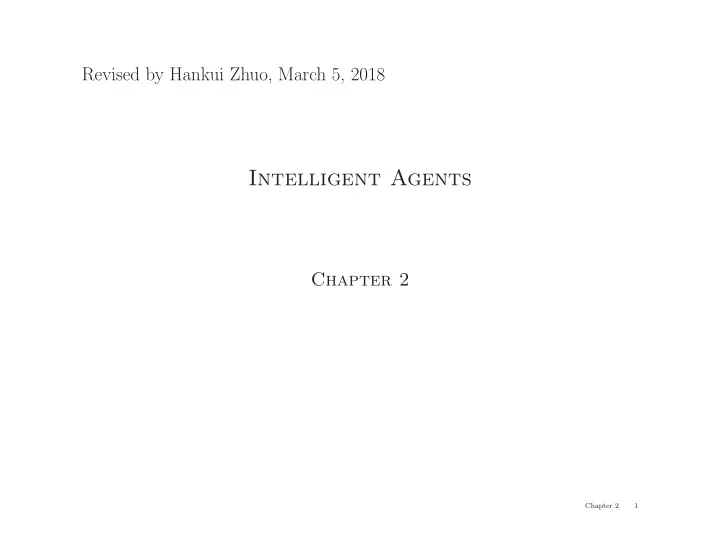

Revised by Hankui Zhuo, March 5, 2018 Intelligent Agents Chapter 2 Chapter 2 1
Outline ♦ Agents and environments ♦ Rationality ♦ PEAS (Performance measure, Environment, Actuators, Sensors) ♦ Environment types ♦ Agent types Chapter 2 2
Agents and environments sensors percepts ? environment agent actions actuators Agents include humans, robots, thermostats, etc. The agent function maps from percept histories to actions: f : P ∗ → A The agent program runs on the physical architecture to produce f Chapter 2 3
Vacuum-cleaner world A B Percepts: location and contents, e.g., [ A, Dirty ] Actions: Left , Right , Suck , NoOp Chapter 2 4
A vacuum-cleaner agent Percept sequence Action [ A, Clean ] Right [ A, Dirty ] Suck [ B, Clean ] Left [ B, Dirty ] Suck [ A, Clean ] , [ A, Clean ] Right [ A, Clean ] , [ A, Dirty ] Suck . . . . . . function Reflex-Vacuum-Agent ( [ location , status ]) returns an action if status = Dirty then return Suck else if location = A then return Right else if location = B then return Left What is the right function? Can it be implemented in a small agent program? Chapter 2 5
Rationality Fixed performance measure evaluates the environment sequence – one point per square cleaned up in time T ? – one point per clean square per time step, minus one per move? – penalize for > k dirty squares? A rational agent chooses whichever action maximizes the expected value of the performance measure given the percept sequence to date Rational � = omniscient – percepts may not supply all relevant information Rational � = clairvoyant – action outcomes may not be as expected Hence, rational � = successful Rational exploration, learning, autonomy ⇒ Chapter 2 6
PEAS To design a rational agent, we must specify the task environment Consider, e.g., the task of designing an automated taxi: Performance measure?? Environment?? Actuators?? Sensors?? Chapter 2 7
PEAS To design a rational agent, we must specify the task environment Consider, e.g., the task of designing an automated taxi: Performance measure?? safety, destination, profits, legality, comfort, . . . Environment?? US streets/freeways, traffic, pedestrians, weather, . . . Actuators?? steering, accelerator, brake, horn, speaker/display, . . . Sensors?? video, accelerometers, gauges, engine sensors, keyboard, GPS, . . . Chapter 2 8
Internet shopping agent Performance measure?? Environment?? Actuators?? Sensors?? Chapter 2 9
Internet shopping agent Performance measure?? price, quality, appropriateness, efficiency Environment?? current and future WWW sites, vendors, shippers Actuators?? display to user, follow URL, fill in form Sensors?? HTML pages (text, graphics, scripts) Chapter 2 10
Agent types Four basic types in order of increasing generality: – simple reflex agents – reflex agents with state – goal-based agents – utility-based agents All these can be turned into learning agents Chapter 2 11
Simple reflex agents Agent Sensors What the world is like now Environment What action I Condition − action rules should do now Actuators Chapter 2 12
Example function Reflex-Vacuum-Agent ( [ location , status ]) returns an action if status = Dirty then return Suck else if location = A then return Right else if location = B then return Left Chapter 2 13
Reflex agents with state Sensors State What the world How the world evolves is like now Environment What my actions do What action I Condition − action rules should do now Agent Actuators Chapter 2 14
Example function Reflex-Vacuum-Agent ( [ location , status ]) returns an action static : last A, last B , numbers, initially ∞ if status = Dirty then . . . Chapter 2 15
Goal-based agents Sensors State What the world How the world evolves is like now Environment What it will be like What my actions do if I do action A What action I Goals should do now Agent Actuators Chapter 2 16
Utility-based agents Sensors State What the world How the world evolves is like now Environment What it will be like What my actions do if I do action A How happy I will be Utility in such a state What action I should do now Agent Actuators Chapter 2 17
Learning agents Performance standard Critic Sensors feedback Environment changes Learning Performance element element knowledge learning goals Problem generator Agent Actuators Chapter 2 18
Summary Agents interact with environments through actuators and sensors The agent function describes what the agent does in all circumstances The performance measure evaluates the environment sequence A perfectly rational agent maximizes expected performance Agent programs implement (some) agent functions PEAS descriptions define task environments Environments are categorized along several dimensions: observable? deterministic? static? discrete? single-agent? Several basic agent architectures exist: reflex, reflex with state, goal-based, utility-based Chapter 2 19
End of Chapter 2 Thanks & Questions! Chapter 2 20
Recommend
More recommend